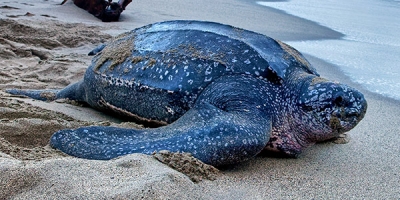
The largest of all the turtles is the leatherback, which can grow up to 1.6 m long and weigh about 360 kg – almost as heavy as a horse. Unlike other turtles, its shell is not hard but slightly flexible with an almost rubber-like feel. It can stay underwater for over an hour and dive to a depth of about 1280 m.
The leatherback sea turtle is the most unique of all sea turtle species. As the only living member of the family Dermochelyidea, they are the largest living turtle species and have the greatest migratory distribution of any reptile on the planet. Its distinguishing feature is its carapace, which has a smooth, leathery skin that covers a flexible matrix of bone. This carapace is highly specialized for diving to extreme depths of up to 4,000 feet (1,219 meters). In addition, a unique thermoregulatory adaptation allows leatherbacks to maintain core body temperatures at these extremely cold depths.
Adult leatherbacks have few natural predators, but their eggs and newborns are preyed upon by many animals, including birds, raccoons, and crabs. Female leatherbacks tend to return to the same nesting area to lay their eggs. Their large size makes them opportunistic in selecting a nesting beach. Like most reptiles, temperature determines the gender of the offspring—if it’s warm inside the nest, females will be born. Likewise, if temperatures are cooler, males develop. Once the eggs hatch, they’re on their own—the baby sea turtles must make it into the water and learn to fend for themselves without any care from their parents. Leatherbacks reach maturity at approximately 16 years old. Their average lifespan is unknown, but it’s thought to be at least 30 years.
Leatherbacks are found in tropical and temperate marine waters all over the world. They live off both the east and west coasts of the United States, and also in Puerto Rico, the Virgin Islands, and Hawaii. Leatherbacks spend most of their lives at sea and sometimes look for prey in coastal waters.
Jellyfish make up the biggest portion of their diet, but they also eat seaweed, fish, crustaceans, and other marine invertebrates. Leatherbacks have downward-pointing spines in their throat, which allows jellyfish to be swallowed, but prevents them from coming back up.
Credit : The National Wildlife Federation
Picture Credit : Google




